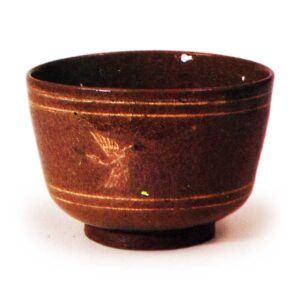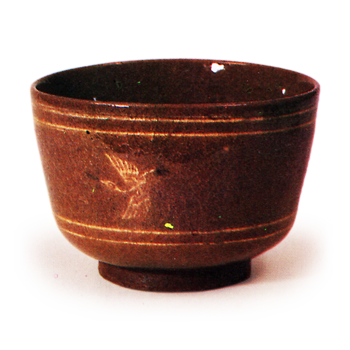
A pottery kiln in Higo Province (Kumamoto Prefecture), also known as Yatsushiroyaki. When Tadatoshi Hosokawa was transferred from Buzen Province (Fukuoka Prefecture) to Higo Province in 1632, Kizo Ueno (Son Kai), who had been engaged in Ueno ware in Buzen Province under Tadaoki, moved with his eldest son Chubei and second son Toshiro, and opened a kiln in Naraki Village, Takada Go, Yatsushiro County (Naraki Town, Yatsushiro City) near Yatsushiro Castle. This was the beginning of Takada pottery. This was the beginning of Takada pottery, and it was the official kiln of the domain. In 1669, Chubei took over the family and Fujishiro became a branch of the family. In 1716, Tarosuke was succeeded as a branch of the family, bringing the total number of Takada-yaki potteries to three, all of which were succeeded by their descendants who received a stipend from the clan. The pottery was generally thinly made, with a reddish-brown clay base and blue-white or black glaze, similar to that of Kochosa, Takatori, and Korean Karatsu, and was called Higo Satsuma by many people.
In the Shoutoku period (1711-16), the fourth generation, Fujishiro, changed the pottery method of Takada-yaki by modifying the raw materials and glaze kiln structure, as well as the method of black-and-white inlaid clay. In addition, during the Bunka era(1804-18), the seventh generation, Nokema, was famous as a master potter. However, with the abolition of the feudal domain in the Meiji era (1868-1912), the pottery gradually declined, and the Hirayama kiln was closed down and moved to Hinaku, Ashikita County (Hinaku, Yatsushiro City), where the two other pottery makers, Niwa San and Yoshiwara Bizo, were engaged in this kiln. The kiln was then moved to Hinaku, Ashikita County (Hinaku, Yatsushiro City), where it has remained ever since. Most of his recent works are tea utensils, which are glazed with a blue-gray color. In addition, the white clay is inlaid with fine lines in the Mishimate style, the Hosokawa family crest, the star of nine days or the chrysanthemum flower, and so on. (Appendix of Pottery Reviews, Novels of Honcho Pottery, Kanko Zusetsu, Kogei Shiryo, Higo Kokushi, Pottery Anthology, History of Japanese Ceramics, Catalogue of Japanese Ceramics).



